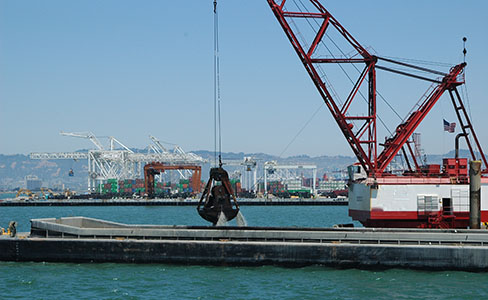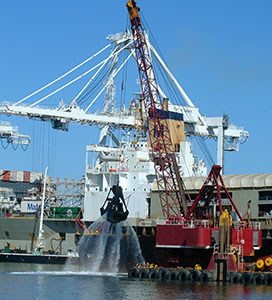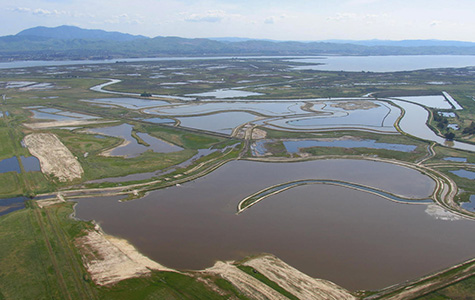It's not often that tampering with Mother Nature proves to be a good thing in the long term, but that's exactly what has happened at the Port of Oakland.

Dredging in the Bay is essential to keep the shipping channels clear for the big container-carrying cargo vessels that are so important to the economy of the local ports and the Bay Area in general. The process clears the mud that travels down the Sacramento and San Joaquin Rivers and gets deposited at the bottom of the Bay, as well as the sand brought in by shifting ocean tides. Photo courtesy of Port of Oakland.
By Bill Picture
It’s not often that tampering with Mother Nature proves to be a good thing in the long term, but that’s exactly what has happened at the Port of Oakland. Last month, the port announced that recent dredging activity yielded 400,000 cubic yards of sediment, every muddy drop of which was deposited at a former wetland near Suisun Bay to help restore the threatened native habitat of endangered fish and wildlife.
“Dredging is not glamorous,” said Port of Oakland Engineering Director Chris Chan. “But it’s essential if we’re going to keep bringing big ships into Oakland, and gratifying when it’s environmentally sustainable.”
The U.S. Army Corps of Engineers periodically dredges the floor of San Francisco Bay to keep clear the channels used by container-carrying cargo vessels traveling to and from the berths at the Port of Oakland. It’s a necessary evil to keep big ships from getting stuck in the mud that travels down the Sacramento and San Joaquin Rivers and gets deposited at the bottom of the Bay, as well as the sand brought in by shifting ocean tides.
Gold Rush leftovers
“Back when we first started dredging, that top layer of sediment contained a lot of contamination from the Gold Rush era,” said Richard Sinkoff, the Port of Oakland’s director of environmental programs and planning. “Being sensitive to the environment wasn’t en vogue back in those days, and miners used all sorts of ecologically unsound practices.”
Inarguably the most harmful to the Bay of those Gold Rush era practices was a process that involved blasting hillsides with water and using mercury to separate gold from the muddy slurry of sand and gravel. Eventually, that mercury found its way into rivers and downstream, and was deposited in the shallow mud on the floor of the San Francisco Bay.
“Over time, the dredging has chipped away that top layer of mud and what’s now coming up is clean sediment,” said Sinkoff. “So we no longer think of the material as a waste byproduct. Instead, we consider it to be a valuable resource, and one that’s quite beneficial to another regional objective of ours, which is restoring the rich wetlands that used to rim the Bay.”
Until just a few decades ago, those tidal areas to which Sinkoff is referring were considered by many people to be a waste of space, and most of them were filled in and developed as a variety of residential, military and commercial sites. By the time anyone noticed that the populations of fish and bird species who called these areas home had collapsed—not to mention the realization that wetlands provide natural flood control and help improve water quality by filtering out contaminants—nearly 90 percent of the Bay Area’s wetlands were either degraded or completely gone.
A new attitude
In 1996, the United States Environmental Protection Agency (EPA), U.S. Army Corps of Engineers, San Francisco Regional Water Quality Control Board, and San Francisco Bay Conservation and Development Commission (BCDC) decided to put their heads together to identify ecologically sound uses for the sediment collected during dredging activity, which until that time was being dumped elsewhere in the Bay or out at sea. The resulting plan, the San Francisco Bay Long Term Management Strategy, called for a decrease in disposal over time, and an increase in the recycling of sediment for “beneficial uses,” including restoring wetlands and maintaining levees.
In the case of the Montezuma Wetlands near Suisun Bay, which received the recent deposit of clean Bay-bottom mud from the Port of Oakland, it was agriculture that brought nature to its knees about a century ago.
“Farmers in the area diked and drained the wetlands so that they could farm the land,” said Doug Lipton, project manager for the Montezuma Wetlands Restoration Project.
In 1990, Montezuma Wetlands LLC, a privately-owned company, began the process of returning about 1,800 acres of farmland to its original wetland state by depositing sediment dredged from the bottom of the Bay.
Montezuma unlike others
While this latest deposit of sediment is clean, Lipton says the Montezuma site is unique because it was engineered also to accept contaminated mud—that is, mud containing higher levels of metals, like the ones resulting from Gold Rush era mining activity. According to Lipton, the contaminated mud is buried deep and covered with clean sediment. Then nature takes care of the rest.
“That contaminated sediment can’t be dumped in the Bay, and when we started accepting it people were very nervous. But we monitor water and sediment quality more than any other project,” Lipton said. “Now that we’ve been safely operating for over two decades and people see these wetlands coming back to life, they’re very supportive.”
To restore the Montezuma Wetlands to their original height will require 1.75 million cubic yards of fill, as the area had subsided ten feet since being drained and sat below sea level.
Montezuma is just one of several regional wetlands restoration projects on the receiving list for dredged-up mud. “We could wait for nature to restore these wetland areas without our intervening, but that process could take decades,” said Sinkoff.
What doesn’t take long, according to Sinkoff, is for the native bird and fish species to reestablish themselves in these refreshed wetland areas. “They’re just waiting for the opportunity and the environment in which to thrive,” he adds. “What we’re doing is laying down the substrata at the historical level so that nature can do its things. It’s like we’re giving nature a primed canvas that it knows how to paint on.”

Dredged material is no longer thought of as a waste byproduct. Instead, it is considered to be a valuable resource, and one thatís quite beneficial to another regional objective, which is restoring the rich wetlands that used to rim the Bay. Photo courtesy of Port of Oakland

Recently, 400,000 cubic yards of sediment were deposited at the Montezuma wetlands near Suisun Bay to help restore the threatened native habitat of endangered fish and wildlife. Photo courtesy of Montezuma Wetlands LLC

